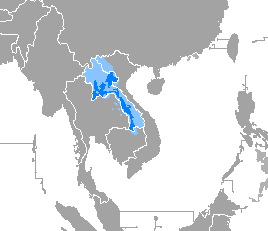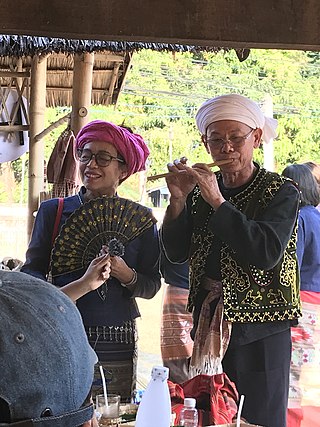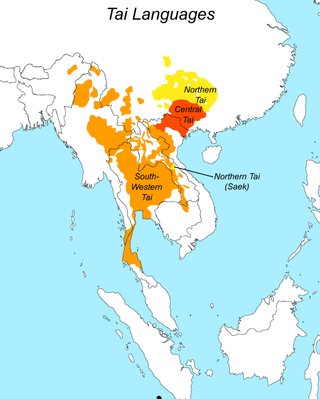Lao may refer to:
Lao may refer to:

Laos, officially the Lao People's Democratic Republic, is a landlocked country in Southeast Asia. At the heart of the Indochinese Peninsula, Laos is bordered by Myanmar and China to the northwest, Vietnam to the east, Cambodia to the southeast, and Thailand to the west and southwest. Its capital and largest city is Vientiane.

The Hmong people are an indigenous group in East and Southeast Asia. In China, the Hmong people are classified as a sub-group of the Miao people. The modern Hmong reside mainly in Southwest China and countries in Southeast Asia such as Vietnam, Laos, Thailand, and Myanmar. There is also a very large diasporic community in the United States, comprising more than 300,000 Hmong. The Hmong diaspora has smaller communities in Australia and South America.

Lao, sometimes referred to as Laotian, is a Kra–Dai language of the Lao people. It is spoken in Laos, where it is the official language for around 7 million people, as well as in northeast Thailand, where it is used by around 23 million people, usually referred to as Isan. Lao serves as a lingua franca among the citizens of Laos, who also speak approximately 90 other languages, many of which are unrelated to Lao.
Ho may refer to:

The Lao people are a Tai ethnic group native to Southeast Asia, who speak the Lao language of the Kra–Dai languages. They are the majority ethnic group of Laos, making up 53.2% of the total population. The majority of Lao people adhere to Theravada Buddhism. They are closely related to other Tai people, especially with the Isan people, who are also speakers of Lao language, native to neighboring Thailand.

Isan or Northeastern Thai refers to the local development of the Lao language in Thailand, after the political split of the Lao-speaking world at the Mekong River, with the eastern bank eventually becoming modern Laos and the western bank the Isan region of Thailand, after the conclusion of the Franco-Siamese War of 1893. The language is still referred to as Lao by native speakers. As a descendant of the Lao language, Isan is also a Lao-Phuthai language of the Southwestern branch of Tai languages in the Kra-Dai language family, most closely related to its parent language Lao and 'tribal' Tai languages such as Phuthai and Tai Yo. Isan is officially classified as a dialect of the Thai language by the Thai government; although Thai is a closely related Southwestern Tai language, it actually falls within the Chiang Saen languages. Thai and Lao are mutually intelligible with difficulty, as even though they share over 80% cognate vocabulary, Lao and Isan have a very different tonal pattern, vowel quality, manner of speaking and many very commonly used words that differ from Thai thus hampering inter-comprehension without prior exposure.
Lao script or Akson Lao is the primary script used to write the Lao language and other minority languages in Laos. Its earlier form, the Tai Noi script, was also used to write the Isan language, but was replaced by the Thai script. It has 27 consonants, 7 consonantal ligatures, 33 vowels, and 4 tone marks.
Tai Lue or Xishuangbanna Dai is a Tai language of the Lu people, spoken by about 700,000 people in Southeast Asia. This includes 280,000 people in China (Yunnan), 200,000 in Burma, 134,000 in Laos, 83,000 in Thailand and 4,960 in Vietnam. The language is similar to other Tai languages and is closely related to Kham Mueang or Tai Yuan, which is also known as Northern Thai language. In Yunnan, it is spoken in all of Xishuangbanna Dai Autonomous Prefecture, as well as Jiangcheng Hani and Yi Autonomous County in Pu'er City.
Tai Dam, also known as Black Tai, is a Tai language spoken by the Tai Dam in Vietnam, Laos, Thailand, and China.
New Tai Lue script, also known as Xishuangbanna Dai and Simplified Tai Lue, is an abugida used to write the Tai Lü language. Developed in China in the 1950s, New Tai Lue is based on the traditional Tai Tham alphabet developed c. 1200. The government of China promoted the alphabet for use as a replacement for the older script; teaching the script was not mandatory, however, and as a result many are illiterate in New Tai Lue. In addition, communities in Burma, Laos, Thailand and Vietnam still use the Tai Tham alphabet.

The Tai Lü people are an ethnic group of China, Laos, Thailand, Burma and Vietnam. They speak a Southwestern Tai language.

The following outline is provided as an overview of and topical guide to Laos:

Tai Tham script is an abugida writing system used mainly for a group of Southwestern Tai languages i.e., Northern Thai, Tai Lü, Khün and Lao; as well as the liturgical languages of Buddhism i.e., Pali and Sanskrit. It is historically known as Tua Tham. In Thailand and Myanmar, the script is often referred to as Lanna script in relation to the historical kingdom of Lan Na situating in the Northern region of modern day Thailand and a part of Shan state in Myanmar. Local people in Northern Thailand also call the script as Tua Mueang in parallel to Kam Mueang, a local name for Northern Thai language. In Laos and Isan region of Thailand, a variation of Tai Tham script, often dubbed Lao Tham, is also known by the locals as To Tham Lao or Yuan script. Tai Tham script is traditionally written on a dried palm leaf as a palm-leaf manuscript.

Vientiane is the capital and largest city of Laos. Comprising the five urban districts of Vientiane Prefecture, the city is located on the banks of the Mekong, right at the border with Thailand. Vientiane was the administrative capital during French rule and, due to economic growth in recent times, is now the economic center of Laos. The city had a population of 1,001,477 as of the 2023 Census.

Tai peoples are the populations who speak the Tai languages. There are a total of about 93 million people of Tai ancestry worldwide, with the largest ethnic groups being Dai, Thais, Isan, Tai Yai (Shan), Lao, Tai Ahom, and Northern Thai peoples.

The Mon–Burmese script (မွန်မြန်မာအက္ခရာ) is an abugida that derives from the Pallava Grantha script of southern India and later of Southeast Asia. It is the basis of the alphabets used for modern Burmese, Mon, Shan, Rakhine, Jingpho and Karen.
Lao is a Unicode block containing characters for the languages of Laos. The characters of the Lao block are allocated so as to be equivalent to the similarly positioned characters of the Thai block immediately preceding it.
Hmong writing refers to the various writing systems that have been used for transcribing various Hmongic languages, spoken by Hmong people in China, Vietnam, Laos, the United States, and Thailand, these being the top five countries. Over a dozen scripts have been reported for Hmong, none of which is considered standard for transcribing the languages in the eyes of the speakers.

The Tai Noi or Lao Buhan script is a Brahmic script that has historically been used in Laos and Isan since about 1500 CE. The contemporary Lao script is a direct descendant and has preserved the basic letter shapes. The script has mostly dropped out of use in the Isan region of Thailand, due to the Thaification policies of the Thai government, that imposed Central Thai culture such as the Thai script throughout the country.